人教版高中英语选修六-Unit4-Reading(教学设计)
- 格式:doc
- 大小:37.00 KB
- 文档页数:3
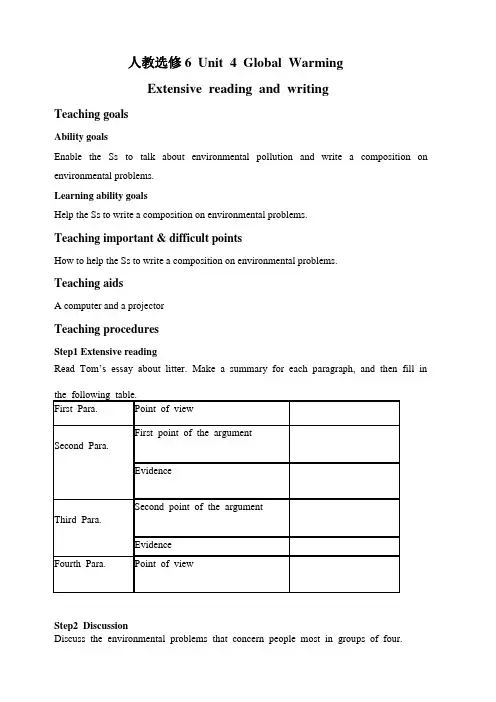
人教选修6 Unit 4 Global WarmingExtensive reading and writingTeaching goalsAbility goalsEnable the Ss to talk about environmental pollution and write a composition on environmental problems.Learning ability goalsHelp the Ss to write a composition on environmental problems.Teaching important & difficult pointsHow to help the Ss to write a composition on environmental problems.Teaching aidsA computer and a projectorTeaching proceduresStep1 Extensive readingRead Tom’s essay about litter. Make a summary for each paragraph, and then fill inthe following table.First Para. Point of viewFirst point of the argumentSecond Para.EvidenceSecond point of the argumentThird Para.EvidenceFourth Para. Point of viewStep2 DiscussionDiscuss the environmental problems that concern people most in groups of four.List as many environment topics as possible, and then write them on a piece of pap er.A sample list of environment topics:air pollution, noise, soil erosion, water pollution, litter classification, desertification, a nd make green by planting treesStep 3 WritingChoose a topic from the list that you feel strongly about. Make notes on your topic using headings similar to the table in the reading task. Use the passage as a model. Writing tips:Step 1: Write out the thesis statement. (point of view)Step 2: Write out the topic sentence of the first body paragraph.Step 3: Give the supporting points and details about the first subtopic.Step 4: Write out the topic sentence of the second body paragraph.Step 5: Give the supporting points and details about the second subtopic. (more body paragraphs ...)A sample version:The Environmental Effects of Fossil FuelsThere is no doubt that fossil fuels bring a lot of good to us. But do you know that many of the environmental problems our country faces today result from our fossil fuel dependence.The environment faces air pollution, global warming, acid rain, and several other ver y serious problems because of our use of fossil fuels. Over the last 150 years, burni ng of fossil fuels has resulted in more than 25 percent increase in carbon dioxide in our atmosphere.Carbon dioxide is one of the main factors in global warming which is negatively aff ecting everyone.Fossil fuels also affect water pollution, land pollution, and thermal pollution (heat pol lution). Coal mining is one of the causes of pollution in the environment. After the mining is completed, the land will remain barren. Materials other than coal are also brought to the surface in the coal mining process and these are left as solid wastes. The production, transportation, and use of fossil fuels are to blame for the effects of pollution on the environment. Then what should we do? We should spare no effort to improve our environment. Please save energy and use fewer fossil fuels in our dai ly lives.Step 4 HomeworkFinish your composition on environmental problems.。
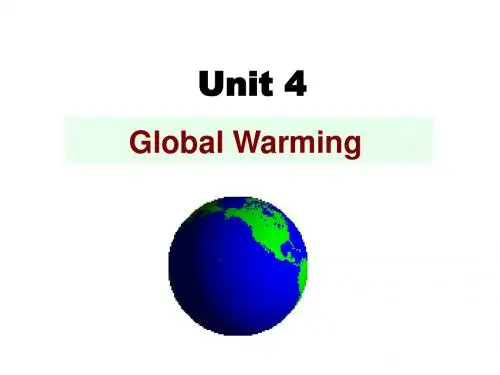
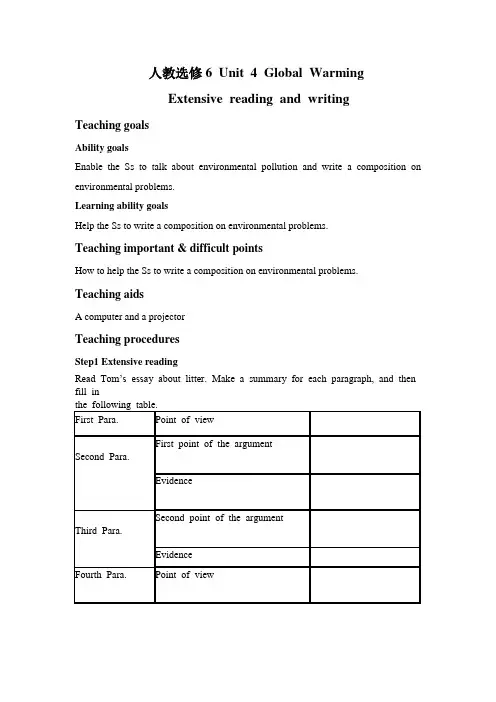
人教选修6 Unit 4 Global WarmingExtensive reading and writingTeaching goalsAbility goalsEnable the Ss to talk about environmental pollution and write a composition on environmental problems.Learning ability goalsHelp the Ss to write a composition on environmental problems.Teaching important & difficult pointsHow to help the Ss to write a composition on environmental problems.Teaching aidsA computer and a projectorTeaching proceduresStep1 Extensive readingRead Tom’s essay about litter. Make a summary for each paragraph, and then fill inStep2 DiscussionDiscuss the environmental problems that concern people most in groups of four. List as many environment topics as possible, and then write them on a piece of paper.A sample list of environment topics:air pollution, noise, soil erosion, water pollution, litter classification, desertificat ion, and make green by planting treesStep 3 WritingChoose a topic from the list that you feel strongly about. Make notes on your topic using headings similar to the table in the reading task. Use the passage as a model.Writing tips:Step 1: Write out the thesis statement. (point of view)Step 2: Write out the topic sentence of the first body paragraph.Step 3: Give the supporting points and details about the first subtopic.Step 4: Write out the topic sentence of the second body paragraph.Step 5: Give the supporting points and details about the second subtopic. (mor e body paragraphs ...)A sample version:The Environmental Effects of Fossil FuelsThere is no doubt that fossil fuels bring a lot of good to us. But do you kno w that many of the environmental problems our country faces today result fro m our fossil fuel dependence.The environment faces air pollution, global warming, acid rain, and several oth er very serious problems because of our use of fossil fuels. Over the last 150 years, burning of fossil fuels has resulted in more than 25 percent increase in carbon dioxide in our atmosphere.Carbon dioxide is one of the main factors in global warming which is negativ ely affecting everyone.Fossil fuels also affect water pollution, land pollution, and thermal pollution (h eat pollution). Coal mining is one of the causes of pollution in the environmen t. After the mining is completed, the land will remain barren. Materials other t han coal are also brought to the surface in the coal mining process and these are left as solid wastes.The production, transportation, and use of fossil fuels are to blame for the effe cts of pollution on the environment. Then what should we do? We should spar e no effort to improve our environment. Please save energy and use fewer fos sil fuels in our daily lives.Step 4 HomeworkFinish your composition on environmental problems.。

Unit4 Global warming一、学生分析本堂课所教学生为高二文科班的学生,积极和活跃是他们在课堂学习实践活动中的特点。
大部分学生经过初中和高一阶段对英语这门语言的学习和掌握,已经为高二阶段的英语学习打下了较好的基础。
表现为:大部分学生能够做到课前预习和准备,课堂上能伴随课程的思路,积极主动的参与课堂活动,如小组讨论,问答练习等;并且部分学生都具有一定的自我约束能力和独立思考的能力,如对某一问题进行讨论时除了能够完成对问题的回答,还能够提出反问甚至是自己独特的见解等。
但是仍有一小部分学生由于种种原因造成了英语基础薄弱,上课不够积极主动,学习任务完成不充分等问题。
对此,在课堂活动中要进行有针对性的帮助。
如进行分组讨论时,可让他们与学习基础好的同学一组且要给予更多的鼓励,使他们尽早能提高对学习英语的兴趣。
本堂课之前学生们已经完成了对Model 6 Unit3 A healthy life 的学习任务,对健康生活的真正涵义也有了一定的理解。
因而在本堂课的引入环节中就结合这个内容进行了设问。
如“健康生活需不需要保护环境呢?”等。
且学生在这一单元以及之前所掌握的英语语言知识技能如:环境和健康的关系;如何开展讨论;如何发表自己的观点等都可以运用到本节课中。
二、本节课教材分析与教材整合1. 单元教材分析本单元以Global warming 为主题,学生通过单元教学经过思考、学习,讨论从而认识到全球变暖的真正涵义和它所带来的种种后果。
同时学生能够进一步认识我们的地球所面临的其它严重问题,激发学生的环保意识。
引导学生运用所学语言知识、句式表达自己对这些现象的看法,培养他们为自己的观点辩论的能力。
Warming Up通过真实的图片再现,使学生对能源的用途和种类有一个基本的了解。
从而为本单元主题Global warming 作了很好的铺垫。
Pre-reading部分组织学生对这些问题的讨论、回答,也让学生有进一步思考的空间,为下一步阅读做好准备。
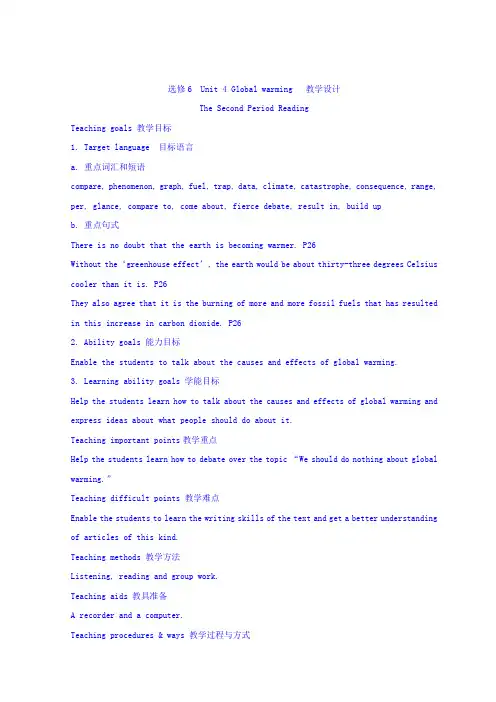
选修6 Unit 4 Global warming 教学设计The Second Period ReadingTeaching goals 教学目标1. Target language 目标语言a. 重点词汇和短语compare, phenomenon, graph, fuel, trap, data, climate, catastrophe, consequence, range, per, glance, compare to, come about, fierce debate, result in, build upb. 重点句式There is no doubt that the earth is becoming warmer. P26Without the‘greenhouse effect’, the earth would be about thirty-three degrees Celsius cooler than it is. P26They also agree that it is the burning of more and more fossil fuels that has resulted in this increase in carbon dioxide. P262. Ability goals 能力目标Enable the students to talk about the causes and effects of global warming.3. Learning ability goals 学能目标Help the students learn how to talk about the causes and effects of global warming and express ideas about what people should do about it.Teaching important points教学重点Help the students learn how to debate over the topic “We should do nothing about global warming.”Teaching difficult points 教学难点Enable the students to learn the writing skills of the text and get a better understanding of articles of this kind.Teaching methods 教学方法Listening, reading and group work.Teaching aids 教具准备A recorder and a computer.Teaching procedures & ways 教学过程与方式Step ⅠRevisionCheck the homework.Review the useful expressions about agreement and disagreement.Show the students some pictures on the screen. The students have to give names of different energy sources relative to the pictures and deicide which energy sources are renewable and which are not. Then ask the students to tell the effects of using these energy sources. Step Ⅱ Pre-readingShow a picture of greenhouse on the screen.T: Now look at the picture. What is it in the picture?S: A greenhouse.T: Right. Who can tell me what it is used for?Sa: A greenhouse is made of glass and is used for growing plants, especially during cold weather.T: Yes, you are right. And how does it work?Sb: The air inside is warm because the glass traps the heat from the sun and keeps it from escaping. This makes the greenhouse heat up and so the plants can grow throughout the cold period.T: Exactly. Thank you. But today we are not going to talk about greenhouse, we’ll talk about greenhouse gases. Have you heard about this before?Sc: I know. In the atmosphere surrounding the earth there are gases, which are called “greenhouse gases”, including carbon dioxide, methane and water vapor.T: That’s correct. Then what do you think greenhouse gases do?Sd: Let me explain it. They trap heat from the sun and therefore warm the earth.T: Yes. Last class we talked about the effects of burning fossil fuels. One of the effects is more and more carbon dioxide is being produced, which in turn increases the speed of global warming. Does it matter? What’re your opinions? Next we’ll read an article “THE EARTH IS BECOMING WARMER —BUT DOES IT MATTER?”Step Ⅲ While-readingGet the students to read the passage fast and meanwhile help the students form a good habit of reading.T: What do you think will be talked abo ut at the sight of the title “THE EARTH IS BECOMING WARMER —BUT DOES IT MATTER?” Now please skim the passage to obtain a general idea of the whole passage. While reading, pay attention to the writing skills and if possible, divide the whole passage into several parts and summarize the main idea for each part. After a few minutes.T: How many parts can this text be divided into?T: Any different ideas? OK. Now let’s finish the form on the screen.Show the form on the screen and let the students complete the form.Main ideas of each part Writing techniquesStep Ⅳ ComprehendingLet the students read the passage again to find out the answers to the questions in Exercises 1 and 2.T: Now let’s listen to th e tape. While listening, pay more attention to specific information. Then read the whole passage by yourselves. Try to find out the answers to questions in Exercises 1 and 2. You may work in groups.Step Ⅴ DebateGet the students to debate over the statement: We should do nothing about global warming. Let them work in groups of six to prepare it.T: Now you are going to have a debate: We should do nothing about global warming. Please follow these instructions.Put the following instructions on the screen.● Get into groups of six. Decide which three in your group are going to agree with the statement (Group A) and which three are going to disagree with the statement (Group B).● Group A discuss why they agree with the statement; Group B discuss why they disagree.● Group A and B get together. Tell each other the reasons why agree or disagree with the statement.T: We don’t have time to do it in class. Please finish it after class. Try to collect as much information as possible on the Internet and share it with the others in class. Next class I’ll get some groups to act out your debates.Step Ⅵ Homework1. Read the passage again and review the new words and expressions.2. Prepare the debate in groups.3. Preview Using Language ― WHAT CAN WE DO ABOUT GLOBAL WARMING?精美句子1、善思则能“从无字句处读书”。
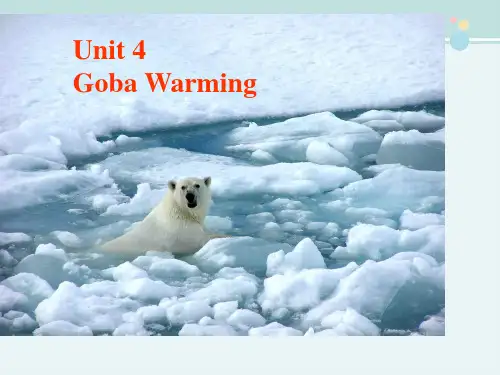
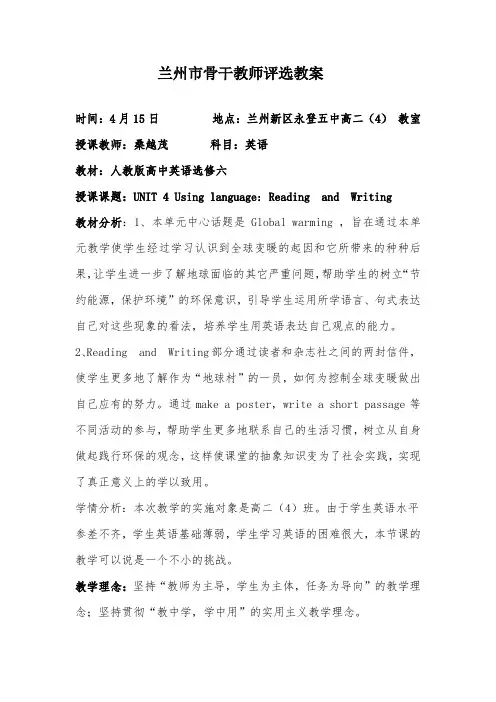
兰州市骨干教师评选教案时间:4月15日地点:兰州新区永登五中高二(4)教室授课教师:桑越茂科目:英语教材:人教版高中英语选修六授课课题:UNIT 4 Using language: Reading and Writing教材分析:1、本单元中心话题是Global warming ,旨在通过本单元教学使学生经过学习认识到全球变暖的起因和它所带来的种种后果,让学生进一步了解地球面临的其它严重问题,帮助学生的树立“节约能源,保护环境”的环保意识,引导学生运用所学语言、句式表达自己对这些现象的看法,培养学生用英语表达自己观点的能力。
2、Reading and Writing部分通过读者和杂志社之间的两封信件,使学生更多地了解作为“地球村”的一员,如何为控制全球变暖做出自己应有的努力。
通过make a poster,write a short passage等不同活动的参与,帮助学生更多地联系自己的生活习惯,树立从自身做起践行环保的观念,这样使课堂的抽象知识变为了社会实践,实现了真正意义上的学以致用。
学情分析:本次教学的实施对象是高二(4)班。
由于学生英语水平参差不齐,学生英语基础薄弱,学生学习英语的困难很大,本节课的教学可以说是一个不小的挑战。
教学理念:坚持“教师为主导,学生为主体,任务为导向”的教学理念;坚持贯彻“教中学,学中用”的实用主义教学理念。
教学方法:学导性教学模式与任务型教学法相结合(基本环节:任务引领——小组合作--交流展示-评价总结)教学目标:1. 知识和技能目标1)知识目标A. 重点词汇和短语: electrical, motor, can (n.), microwave, disagreement, heading, make a difference, put up with, leave an electrical appliance on, so long as等。
B. 重点句式:Together, individuals can make a difference.It takes a lot of energy to make things from new materials. Remember -- your contribution counts‘C.通过学习,让学生更多了解全球变暖现象及成因,以及阻止全球变暖的具体做法。
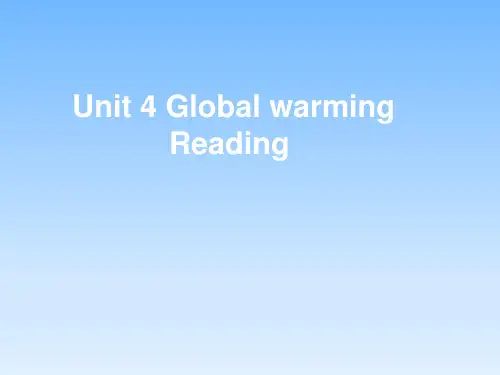
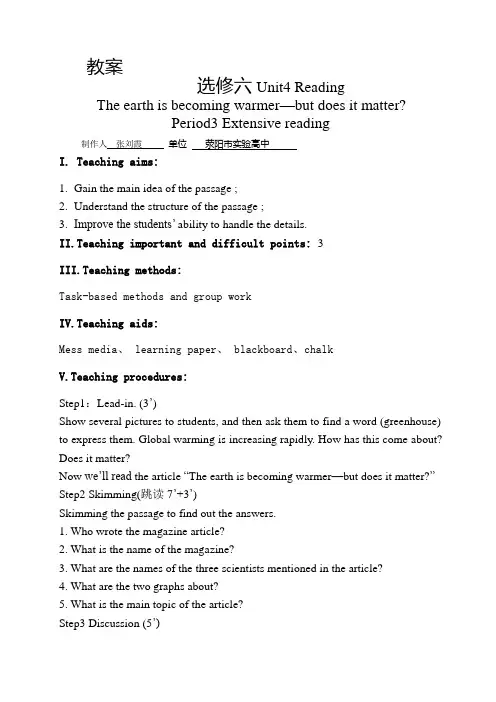
教案选修六Unit4 ReadingThe earth is becoming warmer—but does it matter?Period3 Extensive reading制作人张刘霞单位荥阳市实验高中I. Teaching aims:1.Gain the main idea of the passage ;2.Understand the structure of the passage ;3.Improve the students’ ability to handle the details.II.Teaching important and difficult points: 3III.Teaching methods:Task-based methods and group workIV.Teaching aids:Mess media、 learning paper、 blackboard、chalkV.Teaching procedures:Step1:Lead-in. (3’)Show several pictures to students, and then ask them to find a word (greenhouse) to express them. Global warming is increasing rapidly. How has this come about? Does it matter?Now we’ll read the article “The earth is becoming warmer—but does it matter?”Step2 Skimming(跳读7’+3’)Skimming the passage to find out the answers.1. Who wrote the magazine article?2. What is the name of the magazine?3. What are the names of the three scientists mentioned in the article?4. What are the two graphs about?5. What is the main topic of the article?Step3 Discussion (5’)The earth is becoming warmer. In your opinion, does it matter?What we should do to protect our earth?Step4 Detailed reading (10’)Read the passage carefully to work out whether the statements are true or false.1. The temp erature last century didn’t increase much.2. Everyone believes that global warming is caused by the activities of humans.3. Janice Foster believes that global warming is caused by burning fossil fuels.4. Natural gas is a greenhouse gas.5. Carbon dioxide is a byproduct of burning fossil fuels.6. People accept Charles Keeling’s data because he took accurate measurements. Step5 Scanning(略读,浏览8’)How many paragraphs does the reading text consist of? Please number them. According to the main idea of each part, match them in a right order.Part1 (1) Two different attitudes among scientists towards global warming. Part2 (2-5) How global warming comes about.Part3 (6) Introduce a discussion about global warming.Part4 (7) Leave us a question whether people should do something about global warming or not.Can you match the logic order with each part? (Keys: BADC)A. Giving examples, using graphs, explanationB. Raising a questionC. Leaving a questionD Giving examples, making contrastStep6 Enjoying reading (8’)Read the article thoroughly again and try to understand it by yourself.Step7 Conclusion and Assignment (1’)Read the article carefully and complete the passage.There is no ___ that the earth is becoming warmer. All scientists believe that ___ is human activity that has caused this ___ warming ___ ___ a random but natural phenomenon.The earth i s just like a “greenhouse”. The “greenhouse” gases ___ heat from thesun and ___ the earth. The problem is that we add huge___ of carbon dioxide into the atmosphere by ___ fossil fuels. Consequently, more heat energy tends to be ___, causing global warming. Over the last 100 to 150 years, the ___ of carbon dioxide ___ ___ greatly.However, the attitudes ___ these rises are completely ___ among scientists. They don’t agree with ___ ___. ___ the one hand, some scientists think it could be ___, leading to many ___ like floods, droughts, famines, the ___ of diseases and the ___ of species. On the ___ hand, others ___ ___ ___ the view and hold a ___ attitude. They believe that we should not ___ ___ high levels of carbon dioxide in the air. Which are you in ___ of?No one knows the ___ of global warming.VI.Design on the blackboard:Unit4Period3 Extensive readingStructure引言主体结论Part2 (2-5)Part1 (1) Part4 (7)Part3 (6)VII. Reflection of this class:。

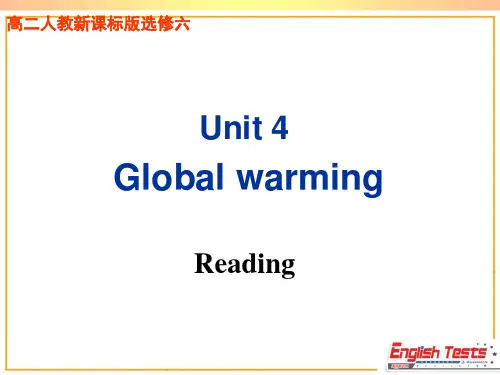
人教版高中英语选修6《Unit 4 Global warming 》教课设计人教版高中英语选修6《 Unit 4 Global warming 》教课设计【一】教课准备教课目的Teaching Aims:In this class Ss will be able to① practice skimming and scanning for information needed like what are the two concerns and what are Earth Cares suggestions.② Master the phrases such as: put up with, so long as, and so on, makea difference, have no effect on , by making sentences or by using theminto the post er.③ bee aware of the serious effects of global warming and the importance of saving energy to be environmentally friendly.④Summarize the points according to their understanding.⑤work together to design a poster by using the suggestions in thearticle.教课重难点Teaching Difficulties:Students may find it hard to add more suggestions about how to save energy in our daily life and to summarize the points according to those suggestions. Students maynot know clear what is a poster and how to design an attractive and persuasive poster in short time.教课过程Teaching Procedure:Step1. Lead-in (inpidual collective work)1.Teacher begins the class by asking: Have you ever seen the movieThe Day After Tomorrow? and then let students enjoy a short movieclip with the following two questions:①What kinds of disasters have you seen in the film?②Can you guess how they came about (happen)?2.introduce the topic:global warming. And then have a further question:①What other disaster will be caused by global warming?【 Designing Purpose 】To arouse students interest by watching the movie clip and educe thetopic, that is global warming. And then by showing a lot of pictures,make students know and understand the terrible effects of global warming, thus making preparations for promoting environmental protection.① who is the writer?② what are his two concerns?Scanning: Read the second letter and answer the following questions:①Does Earth Care agree with Ouy ang Guangs opinion thatinpiduals can have no effect?②what are Earth Cares suggestions?③Can we carry those suggestions out? Why?【Designing Purpose 】To help the students grasp the main information of the two letters by skimming and scanning. While stud ents get the answer to question1,ask them to find the supporting sentence : Together, inpiduals can makea difference. We do not have to put up with pollution. Guess themeanings of the two italicized phrases according to the surroundings andtheir understanding.Step3. Post reading (Pair work)1.Discussion: Make students discuss whether they can find moreways or suggestions about reducing carbon dioxide and saving energy inour daily life.Suggested ways:1)Use less hot water 7)Change a light bulb 8)Try car sharing2)Take a shower instead of a bath3)Buy fresh food instead of frozen4)Buy things that are actually in season5)Eat less high fat food like KFC and Macdonald6)Clean filters(过滤器) on your air conditioner.【Designing Purpose 】To cultivate students to work in pairs and learn to summarize an opinion and share the knowledge of saving energy in daily life. To practice theability of understanding the meaning of new words and expressionsto remove the obstacles in reading.Step4. learn what is a poster (collective work)Know what is a poster by giving a simple sample and try to getthe structure.【Designing Purpose 】To know clearly a poster should have a heading, contents and an eye-catching slogan, which will make it easy for students to design anacceptable poster.Step5. Prepare the poster (inpidual group work)1. Decide our content s:①Choose and decide five most important suggestions. (inpidual work)②W rite them downon your paper and try to makethem persuasive by using imperativesentences. (inpidual work)③pare your list with your group membersand decide five for your poster. (groupwork)2. Slogan and heading: showing sample posters to help them decide aheading and a slogan for your poster.【Designing Purpose 】This is the most important part of this writing task. Students willbe able to summarize and pose sentences by choosing and organizingwhat they want to say, thus improving their writing ability and the processof output based on what they have learned in reading part. And by learning some sample posters to help them decide their own heading and slogan.Step6. produce show time (group work)With the heading, slogan and ways, students will not find it difficultto make a poster. What theyShould pay attention is how to illustrate their poster and makeit more attractive. And then choose several pairs to represent their posters.【Designing Purpose 】Making the poster will improve their cognitive capability of theimportance of environmental protection and at the sametime they can enjoya sense of achievement in show time. And they make believe that inpiduals can really make a difference.课后习题Homework :Put their poster up around the school to make more students know about energy saving and global warming. Write a short passage to tell othershow to solve the problem of global warming based on the suggestionsyou have collected and send it in your zone or blog.板书板书设计: tsunami/ flood/More suggestions: make full use of paper/ use both sides ofpaper reuse waterlimit the time of using private carssend emails instead of cardsuse less hot wateralways take a shopping bag with youdrive a bicycle but not e-bicycle人教版高中英语选修6《Unit 4 Global warming 》教课设计【二】教课准备教课目的Teaching goals教课目的1. Target language目口号言a.要点词汇和短语energy, light (v.), heat (v.), renewable, non-renewable, fuel, blame, run outb.社交用语I dont think so.I dont think thats right.Im afraid you are wrong.2. Ability goals 能力目标Enable the students to talk about different sources of energy andexpress their own ideas.3. Learning ability goals 学能目标Help the students learn how to give their ideas about the use of energy.教课重难点Teaching important points 教课要点Enable the students to express agreement and disagreement.Teaching difficult points 教课难点Enable the students to learn how to express agreement and disagreement.教课过程Step ⅠRevisionT:Good morning, everyone.Ss: Good morning, teacher.T: Sit down, please. Before class, Ill check your homeworkfirst.Mary, would you read your homework to us?Check the students homework and have a discussion with the studentsabout the mistakes Mary made. Let the students have a clear understanding about the mistakes and then correct them.Step ⅡWarming upT: As we all know,we depen d on energy to do many things in our daily life. Some people even say we could do nothing without energy. Can youtell me what we use energy for?Sa: Energy lights our cities.Sb: Energy heats our buildings.Sc: Energy entertains us. With the help of electricity, people havegot a lot of fun from watching TV, playing puters and so on.Sd: There are many other electrical appliances that make our life more convenient and fortable such as washing machines, microwaves,air conditioners and so on.Se: Today energy also helps people realize many so-called dreams inthe past. For example, people can fly from one place to another by planewhich runs on energy.Sf:Its true. In fact, not only planes but also cars, ships and trains run on energy.T:Well done. All that youve just said is right. So it seems that energy plays a very important role in the modern world. Then where does all theenergy e from? Open your books and turn to page 25. Look at thepictures on this page. They may help you find out the answers.After a while.T:Whod like to tell us your answers?Sg: Wind power.Sh: Coal power.T:Right. Is there any difference between them?Si: Yes. Wind will never run out while coal is a limited source.T:Its true. As we know, an energy source is renewable when suppliesof it never run out while some supplies,such as coal, will definitelyrun out one day. Energy of this kind is called non-renewable sources.Please think of as many sources as you can and decide which energy sourceson your list are renewable and which are non-renewable.If necessary, give some words related to the pictures which might bedifficult for the students such as oil refinery,hydroelectric power and so on.The teacher should also collect as much information about differentsources of energy as possible and show it to the students in class through a puter. In this way, the students will bee more interested in this topic and their knowledge on this aspect will be enlarged.T: Fromwhat weve just talked about, it is clear that energy does a lot of good to every coin has two sides. Is there any negative effect of using energy?Sa: use too much energy which is resulting in an increase in carbonis how the global warming es about.Sb: Andmeanwhile it pollutes the environment.T: Itstrue. Many people have realized the problem. Next well do some listeningpractice on this topic. Lets see what other people think of this issue.Thestudents are asked to read the questions quickly to find out the listeningpoints first.Then listen to the tape twice and give the correct answers.T: Nowplease turn to page 31. Lets do listening. Before you listen to the tape,please read fast the statements in Exercise 1 to find out thelistening much attention to the key points while listening.Play thetape for the first time. Help the students get a generalunderstanding aboutthe dialogue. The students listen and try to finishExercise 1. Play the tapeagain, train the students ability to spot specific information and understandthe implication in the dialogue.The students listen and finish Exercise 2.Severalminutes later.T:Have you finished the exercises?Ss: Yes.T: OK,lets check your answers.Explainsome difficult points if necessary.T: Nowread what Professor Chen and Li Bin say. Work in groups. Discuss who you agreewith and give reasons. Use some of the phrases listed in Exercise 2 or anyothers you know.课后习题Homework1.Review the new words and expressions you learned in this class.2.Preview Reading.。
Unit4 Pre-reading and Reading精品教案Teaching Goals:1.To read about global warming.2.To get some idea about the effect of global warming.3.To develop some basic reading skills.Teaching Procedures:Step 1. Warming UpPurpose: To arouse Ss interest in learning about global warming.1. Team workAnswer the questions below:(1) Have you ever seen a greenhouse?(2) How does a greenhouse work?(3) What do you think greenhouse gases do?2. Group workLook at the picture, and ask Ss some questions.T: What is this building made of?S1: It’s made of plastic.T: What’s its purpose?S2: Plants can grow in it when it’s cold outside.T: How does it work?S3: The glass traps the heat from the sun, making the air warm so that plants grow better.Step 2. Pre-readingPurpose: To get Ss to learn about greenhouse gases.1. Group workNow look at the word “GREENHOUSE GASES”. What does it mean?Greenhouse gases (GHG) are gaseous components of theatmosphere that contribute to the greenhouse effect .Themajor natural greenhouse gases are water vapor, whichcauses about 36-70% of the greenhouse effect on Earth (not including clouds): carbon dioxide, which causes between 9-26%; and ozone, which causes between 3-7%(note that it is not really possible to assert that such-and-such a gas causes a certain percentage of the GHE, because the influences of the various gases are not additive .The higher ends of the ranges quoted are for the gas alone ;the lower end ,for the gas counting overlaps).Naturally occurring greenhouse gases include water vapor, carbon dioxide, methane, nitrous oxide, and ozone. Certain human activities, however, add to the levels of most of these naturally occurring gases.Very powerful greenhouse gases that are not naturally occurring include hydrofluorocarbons (HFCs), perfluorocarbons (PFCs), and sulfur hexafluoride (SF6), which are generated in a variety of industrial processes.Each greenhouse gas differs in its ability to absorb heat in the atmosphere. HFCs and PFCs are the most heat-absorbent.2. Individual workGet Ss to answer these questions individually. Then let them discuss the answers.(1) Who wrote the magazine article? What is the name of the magazine?(2) What are the names of the three scientists mentioned in the article?(3) What do they think about global warming? Do they agree with one another?(4) What are the two graphs about?(5) What is the main topic of the article?Step 3. Reading1. SkimmingPurpose: To get a brief understanding of the text.Read through the text, preferably the first and the last sentences of each paragraph and write the key sentence of each paragraph.Key sentences of each paragraph:(1) A debate over whether it is human activity that has caused the global warming or whether it is just a natural phenomenon.(2) Many scientists believe people have caused the increase in the earth’s temperature.。
人教版高中英语选修6
Unit 4 Global warming
Reading: The earth is becoming warmer
—But Does it Matter Teaching aims:
1)Learn the causes of global warming and different attitudes.
2) Master the reading skills.
3) Save energy and prevent the global warming.
|
Important point:
understand the causes and effects of global warming Difficult point:
how to write a meaningful passage about global warming Teaching methods:
individual, pair work, group discussion
Teaching aids
a computer, some slides, a projector
【
Teaching procedures:
Step 1 Lead- in
1 Play a game—wheel of fortune
设计意图:激发学习兴趣, 为阅读课文做好铺垫
2 play a video and answer two questions
设计意图:提前预知课文内容以便更好理解
Step 2 Skimming
1 Structure of the passage
—
1 Introduction
2 Body
3 Conclusion
2 Match the main idea of each part
Part 1 (A) How has global warming come about
Part 2 (B) List two different attitudes
^
Part 3 (C) Should we do anything
Part 4 (D) The earth is becoming warmer
设计意图:整体把握文章结构,思路清晰,便于理解文章内容
Step 3 Scanning
2 The Outline of different opinions
Dr Janice Foster Charles Keeling George Hambley |
Part 1
This article is from ________.
A. a magazine
B. the internet
C. a book
Introduction
of Greenhouse gases
and Greenhouse effect Made accurate measurements of the amount of CO2 ' Predict the global warming will be mild and positive
Step 4 Careful reading
Part 2
1. What’s graph 1 about
2. What’s graph 2 about
¥
3 How does the global warming come about
Part 3
Step 5 Post-reading —discuss
1 We should do something or nothing about global warming.
2 What can we do to reduce the global warming
Step 6 Writing
Write a short passage about global warming (100-120 words)
Step 7 Summary
Step 8 Homework
1 Finish your writing about global warming.
2 Search for more information about global warming on the
Internet.。